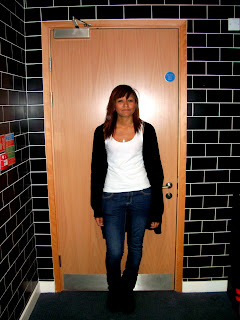
The name of the artist on the digipak is Fiest, this connotes an indie type nature as this is a made up word, already she is not conforming. Fiest also sounds like ‘feisty’; the choice of this name could be a suggestion of the singer’s personality and nature.
The font on the front cover is best described as standard and simple. The lettering is neat and dominant against the white background as they have chose to have black lettering. This continues the black and white theme of the digipak as the images are mostly black and white and the backgrounds are white throughout the digipak. The physical appearance of Fiest on the front cover is highly ambiguous. She appears to be topless but it is hard to tell due to the heavy shadowing, Fiest seems to be doing this to continue the simplistic theme rather than being sexual. Due to her side on pose, the audience doesn’t get to see her full profile, this could be to suggest that there is more to Fiest than this album can imply. The close up shot allows us to take in as much of her as the image allows, Fiest is being ambiguous and challenging us to interpret the image.
Fiest is the dominant image throughout the whole digipak; she is the unique selling point as she is a solo artist. By combining a selection of unique images, Fiest is appealing to her target audience as she appears to be interesting. She also has to be dominant as she was propelled to fame by an iPod advert; she has to be recognisable to the buying public. The upside down image of Fiest suggests that she is more complicated than the front cover image suggests. The record company would have added this image like this due to her indie genre which is all about doing things in a new and different way. The other dominant image is of string, this features on the front cover image and then twice in the digipak. This could be to suggest that everything is somehow connected; however there can be various interpretations, Fiest probably wanted it this way too.
The title of the album is The Reminder; this is because Fiest offers nostalgic music due to her heavy 70’s influence. Fiest is reminding her audience of how music used to be. This is reinforced by the heavy use of sepia and also the Polaroid type shots; Fiest transports us with this digipak. The 70’s feel is continued due to the dominant colours, the black and white images and the sepia tones give the digipak a vintage feel. However, the pieces of string, which are also dominant, are primary colours; this could be to suggest a modern take on the past.
Fiest’s album was produced by many people including, Gonzales, Ben Mink, Renaud Letang and herself. All of the producers are Canadian like Fiest; this would appeal to the audience as it seems the album is heavily influence by her native country. Gonzales is also a recognisable artist as he found fame from an advert just like Fiest. The album won’t have an ‘LA finish’, this is good news for her indie fans.
Fiest’s record label is Cherry Tree, a major label focused on new talent. Their parent companies are Interscope and Polydor for the US and UK respectively. Fiest has the potential to be distributed on a mass scale if the record company chose to. She is also part of Arts and Crafts, an independent Canadian label. Again Fiest has remained true to her roots and seems to be heavily influence by Canada.
Fiest fits into her indie genre due to her artistic take on the digipak. The Polaroids, sepia and black and white images are major favourites of her indie fans. Her target audience would be indie 20-30’s year olds due to the heavy 70’s influence and nostalgia that she offers.
































